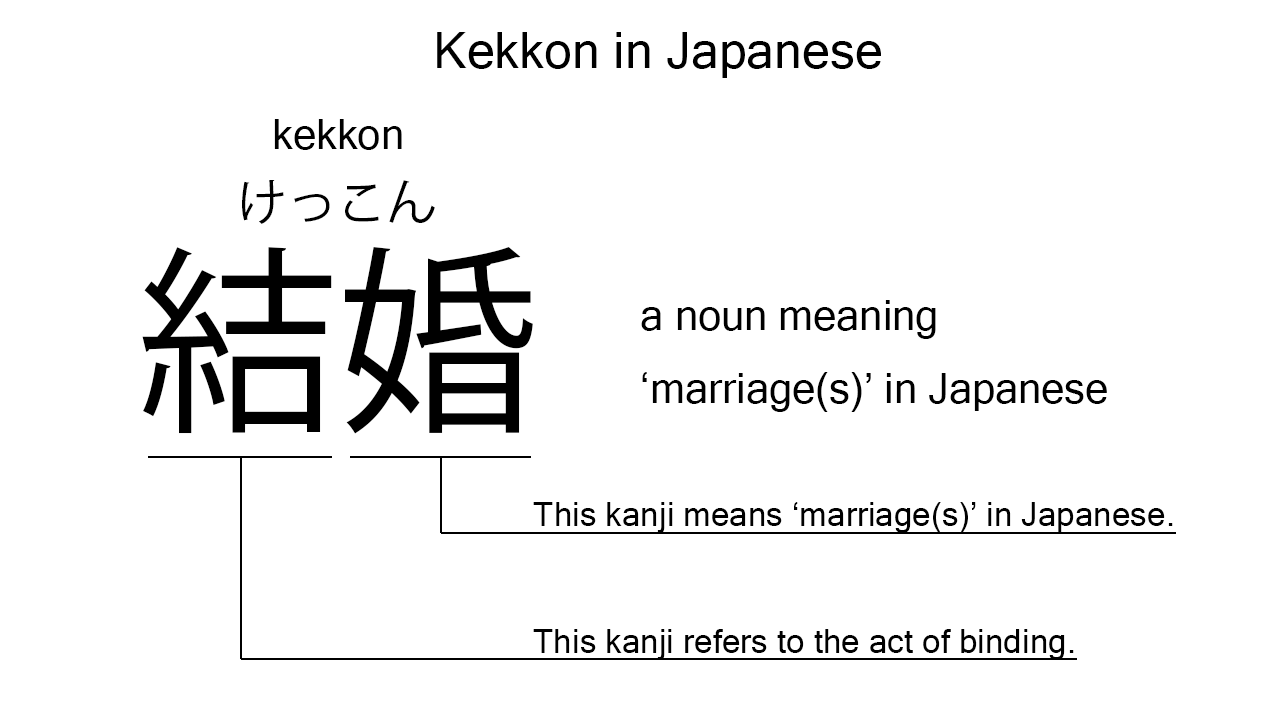What does “kekkon” mean in Japanese?
Native speakers say “kekkon” to mean ‘marriage’ in Japanese. Perhaps, some Japanese learners know this word as it is sometimes used in Japanese movies, songs, novels, manga, anime, and the like. In this blog post, however, I will explain this word in detail based on its kanji expression. And also, I will explain how to use it through example sentences. My explanations would help Japanese learners understand “kekkon” more clearly. Then, let’s get started!
Contents
Definition and meaning of “kekkon”
Let me start with the definition and meaning of “kekkon”.
- kekkon – 結婚 (けっこん) : a noun meaning ‘marriage’ in Japanese. This can also work as plural. Learn more about Japanese plural.
This noun refers to a relationship between two people and cannot mean a ‘wedding ceremony’ in Japanese. It’s worth knowing, I think.
The definition and meaning are simple and clear. To understand this noun more clearly, however, let me explain its kanji characters in detail, one by one.
Kekkon in kanji
The kanji expression of “kekkon” consists of the following two kanji characters:
- 結 : a kanji character used to refer to the act of binding or tying.
- 婚 : a kanji character used to mean ‘marriage’ in Japanese.
These two kanji characters tell us that the formed noun literally means ‘binding marriage’ in Japanese. This literal interpretation is not completely in line with the actual meaning, but still very close, I think. Marriage is a relationship binding two people.

When we meet new kanji expressions, we should check their kanji characters in detail to understand their meanings clearly and deeply. In many cases, kanji characters tell us a lot about the meaning of the expressions they form. Actually, here, we could get the better understanding of “kekkon” through the detailed kanji check above.
So far, I’ve explained the definition and meaning of “kekkon” together with its kanji characters. Then, let me explain how to use it through the example sentences below.
Example #1: how to say “marriage” in Japanese
「kekkon ga kowai」 to kanojo wa it ta – 「結婚が怖い」と彼女は言った (「けっこんがこわい」とかのじょはいった)
“Marriage is scary,” she said.
Below are the new words used in the example sentence.
- ga – が : a case particle used to make the subject word or the object word in a sentence. In the example, this is used after “kekkon” to make the subject in the clause.
- kowai – 怖い (こわい) : an i-adjective meaning ‘scary’ or such in Japanese.
- to – と : a case particle working as a quote marker. In the example, this works after the clause to indicate what she said.
- kanojo – 彼女 (かのじょ) : a pronoun meaning ‘she’ in Japanese.
- wa – は : a binding particle working as a case marker or topic marker. In the example, this works after “kanojo” to make the subject in the sentence.
- it – 言っ (いっ) : one conjugation of the verb, “iu“, which means ‘to say’ or such in Japanese. In the example, it has been conjugated for the better connection with its following word.
- ta – た : an auxiliary verb used after a verb, adjective, or auxiliary verb to make its past tense form. In the example, this is used after “it” to make its past tense form, “it ta”.
This is a typical usage of “kekkon”. In this example, it works together with the case particle, “ga”, to become the subject in the clause.
Example #2: another usage of “kekkon”
kekkon wa waruku nai yo – 結婚は悪くないよ (けっこんはわるくないよ)
Marriage is not bad.
Below are the new words used in the example sentence.
- waruku – 悪く (わるく) : one conjugation of the i-adjective, “warui“, which means ‘bad’ in Japanese. In the example, it has been conjugated for the better connection with its following word.
- nai – ない : an auxiliary verb used after a verb, adjective, or auxiliary verb to deny its meaning. In the example, this is used after “waruku” to deny its meaning. Word orders in Japanese and English are different, but the role of this auxiliary verb is similar to that of “not” in English.
- yo – よ : a sentence-ending particle used to state the fact or idea in a soft way. As the definition suggests, this is used at the end of the example sentence to state the speaker’s idea softly.
This is another typical usage of “kekkon”. When we want to mean ‘marriage’ in Japanese, this noun is always a very good option.
Summary
In this blog post, I’ve explained the definition and meaning of “kekkon” in detail based on its kanji expression. And also, I’ve explained how to use it through the example sentences. Let me summarize them as follows.
- kekkon – 結婚 (けっこん) : a noun meaning ‘marriage’ in Japanese. This can also work as plural. These two kanji characters literally mean ‘binding marriage’ in Japanese. This literal interpretation is not completely in line with the actual meaning, but still very close, I think. Marriage is a relationship binding two people. It’s also worth mentioning here that this noun refers to a relationship between two people and cannot mean a ‘wedding ceremony’ in Japanese.
Hope my explanations are understandable and helpful for Japanese learners.